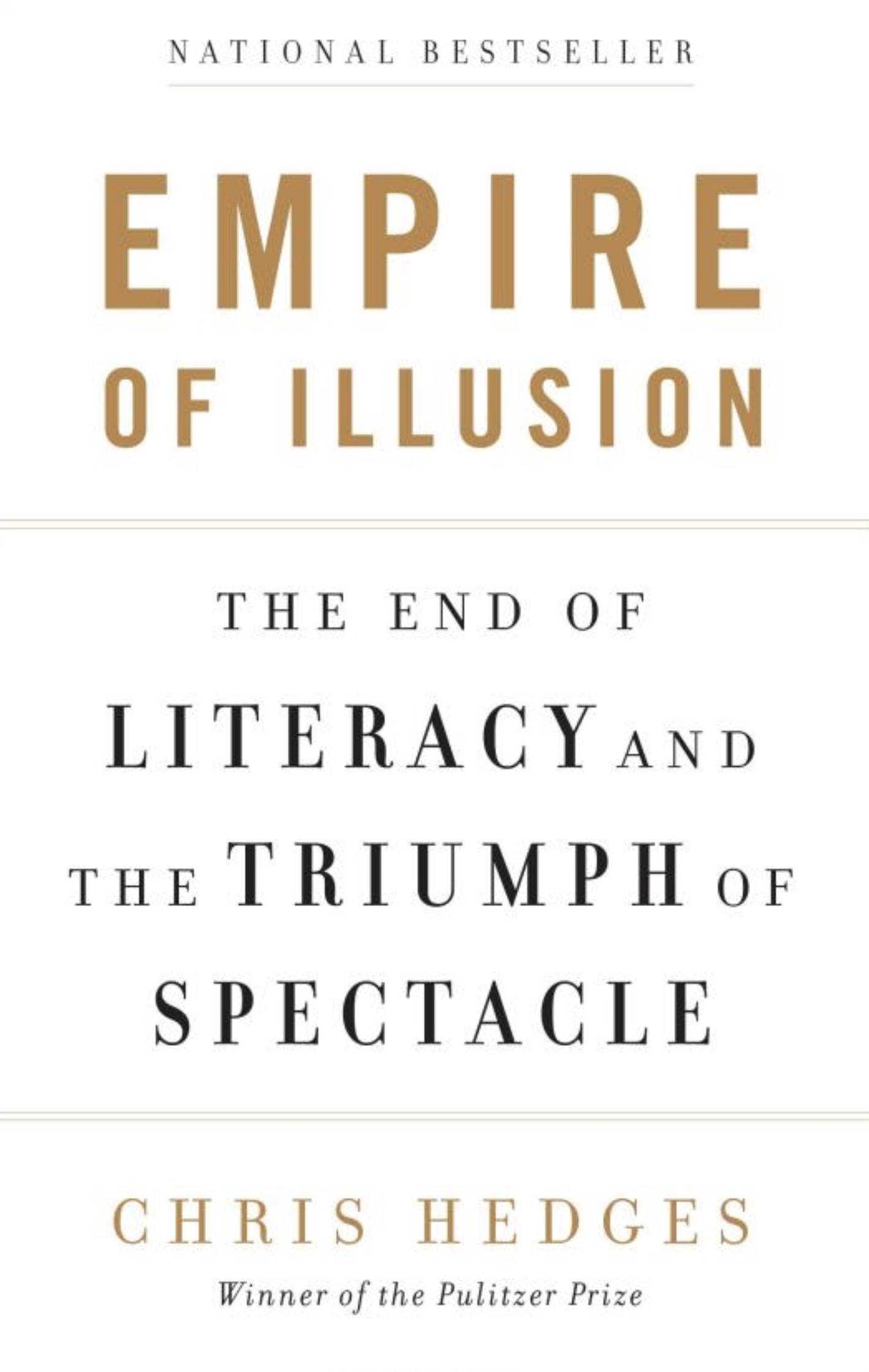Book Excerpt: ‘Empire of Illusion’
Read this brilliant and humorous chapter from Chris Hedges' new book and marvel as the Pulitzer Prize-winning war correspondent makes sense of reality television.
Read this brilliant and humorous chapter from Chris Hedges’ new book and marvel as the Pulitzer Prize-winning war correspondent makes sense of reality television.
Adapted from “Empire of Illusion: The End of Literacy and the Triumph of Spectacle,” available from Nation Books, a member of the Perseus Books Group. Copyright © 2009.
Celebrity worship banishes reality. And this adulation is pervasive. It is dressed up in the language of the Christian Right, which builds around its leaders, people like Pat Robertson or Joel Olsteen, the aura of stardom, fame and celebrity power. These Christian celebrities travel in private jets and limousines. They are surrounded by retinues of bodyguards, have television programs where they cultivate the same false intimacy with the audience, and, like all successful celebrities, amass personal fortunes. The frenzy around political messiahs, or the devotion of millions of women to Oprah Winfrey, is all part of the yearning to see ourselves in those we worship. We seek to be like them. We seek to make them like us. If Jesus and The Purpose Driven Life won’t make us a celebrity, then Tony Robbins or positive psychologists or reality television will. We are waiting for our cue to walk onstage and be admired and envied, to become known and celebrated.
“What does the contemporary self want?” asked critic William Deresiewicz:
The camera has created a culture of celebrity; the computer is creating a culture of connectivity. As the two technologies converge — broadband tipping the Web from text to image; social-networking sites spreading the mesh of interconnection ever wider — the two cultures betray a common impulse. Celebrity and connectivity are both ways of becoming known. This is what the contemporary self wants. It wants to be recognized, wants to be connected: It wants to be visible. If not to the millions, on Survivor or Oprah, then to the hundreds, on Twitter or Facebook. This is the quality that validates us, this is how we become real to ourselves — by being seen by others. The great contemporary terror is anonymity. If Lionel Trilling was right, if the property that grounded the self in Romanticism was sincerity, and in modernism was authenticity, then in postmodernism it is visibility.
We pay a variety of lifestyle advisers — Neal Gabler calls them “essentially drama coaches” — to help us look and feel like celebrities, to build around us the set for the movie of our own life. Martha Stewart built her financial empire, when she wasn’t insider trading, telling women how to create and decorate a set design for the perfect home. The realities within the home, the actual family relationships, are never addressed. Appearances make everything whole. Plastic surgeons, fitness gurus, diet doctors, therapists, life coaches, interior designers, and fashion consultants all, in essence, promise to make us happy, to make us celebrities. And happiness comes, we are assured, with we look and how we present ourselves to others. There are glossy magazines like Town & Country which cater to the absurd pretensions of the very rich to be celebrities. They are photographed in expensive designer clothing inside the lavishly decorated set-pieces that are their homes. The route to happiness is bound up in how skillfully we show ourselves to the world. We not only have to conform to the dictates of this manufactured vision, but we also have to project an unrelenting optimism and happiness.
The Swan was a Fox reality makeover show. The title of the series referred to Hans Christian Andersen’s fairy tale “The Ugly Duckling,” in which a bird thought to be homely grew up and became a swan. “Unattractive” women were chosen to undergo three months of extensive plastic surgery, physical training, and therapy for a “complete life transformation.” Each episode featured two “ugly ducklings” who compete with each other to go on to the Swan beauty pageant. “I am going to be a new person,” said one contestant in the opening credits.
In one episode, Cristina, twenty-seven, an Ecuador-born office administrator from Rancho Cordova, California, was chosen to be on the program.
“It’s not just the outside I want to change, but it’s the inside, too,” Cristina told the camera mournfully. She had long black hair and light brown skin. She wore baggy gray sweatshirts and no makeup. Her hair was pulled back. We discovered that she was devastatingly insecure about being intimate with her husband because of her post-pregnancy stretch marks. The couple considered divorce.
“I just want to be, not a completely different person, but I want to be a better Cristina,” she said.
As a “dream team” of plastic surgeons discussed the necessary corrections, viewers saw a still image of Cristina, in a gray cotton bra and underwear, superimposed on a glowing blue grid. Her small, drooping breasts, wrinkled stomach, and fleshy thighs were apparent. A schematic figure of an idealized female form revolved at the left of the screen. Crosshairs targeted and zoomed in on each flawed area of Cristina’s face and body. The surgical procedures she would undergo were typed out beside each body part. Brow lift, eye lift, nose job, liposuction of chin and cheeks, dermatologist visits, collagen injections, LASIK eye surgery, tummy tuck, breast augmentation, liposuction of thighs, dental bleaching, full dental veneers, gum tissue recontouring, a 1,200-calorie daily diet, 120 hours in the gym, weekly therapy, and coaching. The effect was suggestive of a military operation. The image of a blueprint and crosshairs was used repeatedly through the program.
Cristina was shown writing in her diary: “I want a divorce because I think that my husband can do better without me. And it would be best for us to go in different directions. I am not happy with myself at all, so I think, why make this guy unhappy for the rest of his life?”
At the end of the three months, Cristina and her opponent, Kristy, were finally allowed to look in a mirror for “the final reveal.” They were brought separately to what looked like a marble hotel foyer. Curving twin staircases with ornate iron banisters framed the action. A crystal chandelier glittered at the top of the stairs. Sconces and oil paintings in gold frames hung on the cream-colored walls.
The “dream team” was assembled in the marble lobby. Massive peach curtains obscured one wall.
“I think Cristina has really grown into herself as a woman, and she’s ready to go back home and start her marriage all over again,” said the team therapist.
Two men in tuxedos opened a set of tall double doors. Cristina entered in a tight black evening gown and long black gloves. She was meticulously made up, and her hair had been carefully styled with extensions. The “dream team” burst into applause and whoops.
“I’ve been waiting twenty-seven years for this day,” Cristina told host Amanda Byram tearfully. “I came for a dream, the American dream, like all the Latinas do, and I got it!”
“You got it!” cheered Byram. “Yes, you did!”
Reverberating drumbeats were heard. “Behind that curtain,” says Byram, “is a mirror. We will draw back the curtain, the mirror will be revealed, and you will see yourself for the first time in three months. Cristina, step up to the curtain.”
Short, suspenseful cello strokes were heard. There was a tumbling drumroll.
“I’m ready,” quavered Cristina.
The curtain parted slowly in the middle. An elaborate full-length mirror reflected Cristina. The cello strokes billowed into the Swan theme song.
“Oh, my God!” she gasped, covering her face. She doubled over. Her knees buckled. She almost hit the floor. “I am so beautiful!!!” she sobbed. “Thank you, oh, thank you so much!! Thank you, God!! Thank you, thank you, thank you so much for this!! Look at my arms, my figure … I love the dress! Thank you, oh!! I’m in love with myself!”The “dream team” burst into applause again. “Well, you owe this to yourself,” said Byram. “But you also owe it to these fantastic experts. Guys, come on in.”
The crowd of smiling experts closed in on their creation, clapping as they approached.
At the end of each episode the two contestants were called before Byram to hear who would advance to the pageant. The winner often wept and was hugged by the loser. Byram then pulled the loser aside for “one final surprise.” The double doors opened once more, and her family was invited onto the set for a joyful reunion. In celebrity culture, family is the consolation prize for not making it to the pageant.
The Swan’s transparent message is that once these women have been surgically “corrected” to resemble mainstream celebrity beauty as closely as possible, their problems will be solved. “This is a positive show where we want to see how these women can make their dreams come true once they have what they want,” said Cecile Frot-Coutaz, CEO of FremantleMedia North America, producers of The Swan. Troubled marriages, abusive relationships, unemployment, crushing self-esteem problems — all will vanish along with the excess fat off their thighs. They will be new. They will be flawless. They will be celebrities.
In the Middle Ages, writes Alain de Botton in his book Status Anxiety, stained glass windows and vivid paintings of religious torment and salvation controlled and influenced social behavior. Today we are ruled by icons of gross riches and physical beauty that blare and flash from television, cinema, and computer screens. People knelt before God and the church in the Middle Ages. We flock hungrily to the glamorous crumbs that fall to us from glossy magazines, talk and entertainment shows, and reality television. We fashion our lives as closely to these lives of gratuitous consumption as we can. Only a life with status, physical attributes and affluence is worth pursuing.
Hedonism and wealth are openly worshipped on shows such as The Hills, Gossip Girl, Sex and the City, My Super Sweet 16, and The Real Housewives of … The American oligarchy, one percent of whom control more wealth than the bottom ninety percent combined, are the characters we envy and watch on television. They live and play in multimillion-dollar beach houses and expansive modern lofts. They marry professional athletes and are chauffeured in stretch limos to spa appointments. They rush from fashion shows to movie premieres, flaunting their surgically enhanced, perfect bodies in haute couture. Their teenagers throw $200,000 parties and have $1 million dollar weddings. This life is held before us like a beacon. This life, we are told, is the most desirable, the most gratifying.
The working classes, comprising tens of millions of struggling Americans, are shut out of television’s gated community. They have become largely invisible. They are mocked, even as they are tantalized, by the lives of excess they watch on the screen in their living rooms. Almost none of us will ever attain these lives of wealth and power. Yet we are told that if we want it badly enough, if we believe sufficiently in ourselves, we too can have everything. We are left, when we cannot adopt these impossible lifestyles as our own, with feelings of inferiority and worthlessness. We have failed where others have succeeded.
We consume countless lies daily, false promises that if we spend more money, if we buy this brand or that product, if we vote for this candidate, we will be respected, envied, powerful, loved, and protected. The flamboyant lives of celebrities and the outrageous characters on television, movies, professional wrestling, and sensational talk shows are peddled to us, promising to fill up the emptiness in our own lives. Celebrity culture encourages everyone to think of themselves as potential celebrities, as possessing unique if unacknowledged gifts. It is, as Christopher Lasch diagnosed, a culture of narcissism. Faith in ourselves, in a world of make-believe, is more important than reality. Reality, in fact, is dismissed and shunned as an impediment to success, a form of negativity. The New Age mysticism and pop psychology of television personalities, evangelical pastors, along with the array of self-help bestsellers penned by motivational speakers, psychiatrists, and business tycoons, all peddle a fantasy. Reality is condemned in these popular belief systems as the work of Satan, as defeatist, as negativity or as inhibiting our inner essence and power. Those who question, those who doubt, those who are critical, those who are able to confront reality and who grasp the hollowness of celebrity culture, are shunned and condemned for their pessimism. The illusionists who shape our culture, and who profit from our incredulity, hold up the gilded cult of us. Popular expressions of religious belief, personal empowerment, corporatism, political participation, and self-definition argue that all of us are special, entitled, and unique. All of us, by tapping into our inner reserves of personal will and undiscovered talent, by visualizing what we want, can achieve, and deserve to achieve, happiness, fame, and success. This relentless message cuts across ideological lines. This mantra has seeped into every aspect of our lives. We are all entitled to everything.
American Idol, a talent-search reality show that airs on Fox, is one of the most popular shows on American television. The show travels to different American cities in a “countrywide search” for the contestants who will continue to the final competition in Hollywood. The producers of the show introduced a new focus in the 2008-2009 season on the personal stories of the contestants.
During the Utah auditions we meet Megan Corkrey, 23, the single mother of a toddler. She has long dirty-blond hair, and a wholesome, pretty face. A tattoo sleeve covers her right arm from the shoulder to below the elbow. She wears a black, grey, and white dress reminiscent of the 1950s, and ballet flats. She is a font designer.
In an interview Corkrey says, “I am a mother. He will be two in December.” We see Corkrey with a little blond boy, reading a book together on a beanbag chair. Breezy guitar music plays. “His name is Ryder.” We see Corkrey kissing Ryder and putting him to bed. “I recently decided to get a divorce, which is new.” The guitar music turns pensive. “The life I had planned for us, the life I’d pictured, wasn’t going to happen. I cried a lot for a while. I don’t think I stopped crying. And Ryder, of course, you can be crying, and then he walks by, and does something ridiculous, and you can’t help but smile and laugh.” We see Corkrey laughing with her son on the floor. “And a little piece kind of heals up a little bit.”
The montage of Corkrey’s life fills the screen as the rock ballad swells. “I can laugh at myself, while the tears roll down …,” sings the band. We see Corkrey and her son looking out a window. She holds her son up to a basketball hoop as he clutches a blue ball.
“It was kind of crazy, I found out Idol was coming to Salt Lake, and I’d just decided on the divorce, and for the first time in my life it was a crossroads where ANYTHING can happen!! So why not go for what I love to do?”Corkrey enters the audition room. The judges — Simon Cowell, Paula Abdul, Randy Jackson, and Kara DioGuardi — are seated behind a long table in front of a window. They each have large red tumblers with “Coca-Cola” printed on them. They seem charmed by her exuberant presence. She sings “Can’t Help Lovin’ Dat Man” from Show Boat. Her performance is charismatic and quirky. She improvises freely and assuredly with the rhythms and notes of the song, beaming the whole time.
“I really like you,” says Abdul. “I’m bordering on loving you. I think I’m loving you. Yeah, I do. Simon?”
“One of my favorite auditions,” says Cowell in a monotone.
“Yess!!” grins Corkrey.
“Because you’re different,” continues Cowell sternly. “You are one of the few I’m going to remember. I like you, I like your voice, I mean seriously good voice. I loved it.”
“You’re an interesting girl. You have a glow about you, you have an incredible face,” says DioGuardi.
The judges vote.
“Absolutely yes,” says Cowell.
“Love you,” says Abdul.
“Yes!” says DioGuardi.
“One hundred percent maybe,” smiles Jackson.
“You’re goin’ to Hollywood!” cheers DioGuardi as the inspirational rock music swells.
“YESS!!! Thank you, guys!” Corkrey screams with delight. She runs out of the audition room into a crowd of her cheering friends. The music plays as she dances down the street waving her large yellow ticket, the symbol of her success.
Celebrities, who often come from humble backgrounds, are held up as proof that anyone, even we, can be adored by the world. These celebrities, like saints, are living proof that the impossible is always possible. Our fantasies of belonging, of fame, of success and of fulfillment, are projected onto celebrities. These fantasies are stoked by the legions of those who amplify the culture of illusion, who persuade us that the shadows are real. The juxtaposition of the impossible illusions inspired by celebrity culture and our “insignificant” individual achievements, however, eventually leads to frustration, anger, insecurity, and invalidation. It results, ironically, in a self-perpetuating cycle that drives the frustrated, alienated individual with even greater desperation and hunger away from reality, back toward the empty promises of those who seduce us, who tell us what we want to hear. We beg for more. We ingest these lies until our money runs out. And when we fall into despair we medicate ourselves, as if the happiness we have failed to find in the hollow game is our deficiency. And, of course, we are told it is.
Human beings become a commodity in a celebrity culture. They are objects, like consumer products. They have no intrinsic value. They must look fabulous and live on fabulous sets. Those who fail to meet the ideal are belittled and mocked. Friends and allies are to be used and betrayed during the climb to fame, power and wealth. And when they are no longer useful they are to be discarded. In Fahrenheit 451, Ray Bradbury’s novel about a future dystopia, people spend most of the day watching giant television screens that show endless scenes of police chases and criminal apprehensions. Life, Bradbury understood, once it was packaged and filmed, became the most compelling form of entertainment.
The moral nihilism of celebrity culture is played out on reality television shows, most of which encourage a dark voyeurism into other people’s humiliation, pain, weakness, and betrayal. Education, building community, honesty, transparency, and sharing are qualities that will see you, in a gross perversion of democracy and morality, voted off a reality show. Fellow competitors for prize money and a chance for fleeting fame elect to “disappear” the unwanted. In the final credits of the reality show America’s Next Top Model, a picture of the woman expelled during the episode vanishes from the group portrait on the screen. Those cast aside become, at least to the television audience, non-persons. Life, these shows teach, is a brutal world of unadulterated competition. Life is about the personal humiliation of those who oppose us. Those who win are the best. Those who lose deserve to be erased. Compassion, competence, intelligence, and solidarity with others are forms of weakness. And those who do not achieve celebrity status, who do not win the prize money or make millions in Wall Street firms, deserve to lose. Those who are denigrated and ridiculed on reality television, often as they sob in front of the camera, are branded as failures. They are responsible for their rejection. They are deficient.
In an episode from the second season of the CBS reality game show Survivor, cast members talk about exceptional friendships they have made within their “tribe,” or team. Maralyn, also known as Mad Dog, is a fifty-two-year-old retired police officer with a silver crew cut and a tall, mannish build. She is sunning herself in a shallow stream, singing “On the Street Where You Live.” Tina, a personal nurse and mother, walks up the stream toward her.
“Sing it, girl! I just followed your voice.”
“Is it that loud?”
“Maralyn, she’s kind of like our little songbird, and our little cheerleader in our camp,” Tina says in an interview. “Maralyn and I have bonded, more so than I have with any of the other people. It might be our ages, it might just be that we kind of took up for one another.”
We see Tina and Maralyn swimming and laughing together in the river.
“Tina is a fabulous woman,” says Maralyn in an interview. “She is a star. I trust Tina the most.”
Maralyn and Tina’s tribe, Ogakor, loses an obstacle course challenge, in which all the tribe members are tethered together. If one person falls, the entire team is slowed. Mad Dog Maralyn falls several times, and is hauled back to her feet by Colby, the “cowboy” from Texas.
Because they lost, the members of Ogakor must vote off one of their tribe members. The camera shows small groups of twos and threes in huddled, intense discussion.
“The mood in the camp is a very sad mood, but it’s also a very strategic mood,” says Tina. “Everyone’s thinking, ‘Who’s thinking what?’ ”
The vote is taken at dusk, in the “tribal council” area. It resembles a set from Disney World’s Adventureland. A ring of tall stone monoliths is stenciled with petroglyphs. It is lit by torches. A campfire blazes in the center of the ring. Primitive drums and flutes are heard.
The Ogakor team arrives at dusk, each holding a torch. They sit before Survivor’s host, Jeff Probst.
“So I just want to talk about a couple of big topics,” says Probst, who wears a safari outfit. “Trust. Colby, is there anyone here that you don’t trust, wouldn’t trust?”
“Sure,” says Colby.
“Tell me about that.”
“Well, I think that’s part of the game,” says Colby. “It’s way too early to tell exactly who you can trust, I think.”
“What about you, Mitchell? Would you trust everyone here for forty-two days?” asks Probst. “I think the motto is, ‘Trust no one,’ ” answers Mitchell. “I have a lot of faith in a good number of these people, but I couldn’t give 100 percent of my trust.”
“What about you, Mad Dog?” asks Probst. “These all your buddies?”
Maralyn looks around at her team members. “Yes,” she says unequivocally. “Yes. And, Jeff, I trust with my heart.”“I think friendship does enter into it at some point,” says Jerri. “But I think it’s very important to keep that separate from the game. It’s two totally different things. And that’s where it gets tricky.” Jerri will say later, as she casts her vote, “This is probably one of the most difficult things for me to do right now. It’s purely strategic, it’s nothing personal. I am going to miss you dearly.”
“Jeff,” Maralyn breaks in. “I’m conjoined with Tina. She is a constellation. And, the cowboy [Colby]! The poor cowboy has dragged me around so many times [during the obstacle course challenge]. I appreciate it.”
“I’d do it again,” laughs Colby broadly.
“Hey, you hear that? He’d do it again!” says Maralyn.
It is time to vote. Each team member walks up a narrow bridge lit by flaring torches, again looking like something out of Disney’s Enchanted Tiki Room, made of twisted logs lashed with vines, to a stone table. They write the name of the person they want to eliminate and put it in a cask with aboriginal carvings. Most of the votes are kept anonymous, the camera panning away as each person writes. But as Tina, Mad Dog Maralyn’s best friend and “constellation,” casts her vote, she shows us her ballot: Mad Dog. “Mad Dog, I love you,” she says to the camera, “I value your friendship more than anything. This vote has everything to do with a promise I made, it has nothing to do with you. I hope you’ll understand.” She folds her vote and puts it in the cask.
“Once the vote is tallied, the decision is final, and the person will be asked to leave the tribal council area immediately,” says Probst.
Five people of the seven voted to eliminate Maralyn.
“You need to bring me a torch, Mad Dog,” says Probst. She does so, first taking off her green baseball cap and putting it affectionately on Amber, who sits next to her and gives her a hug. The camera shows Tina looking impassive.
“Mad Dog,” says Probst, holding the flaming torch Maralyn has brought him, “the tribe has spoken.” He takes a large stone snuffer and extinguishes the torch. The camera shows Marilynn’s rueful face behind the smoking, blackened torch. “It’s time for you to go,” says Probst. She leaves without speaking or looking at anyone, although there are a few weak “bye” ’s from the tribe.
Before the final credits, we are shown who, besides her friend Tina, voted to eliminate Maralyn. They are Amber, who gave Maralyn a farewell hug along with Mitchell, Jerri and Colby, Maralyn’s “cowboy.”
Celebrity culture plunges us into this moral void. No one has any worth beyond his or her appearance, usefulness, or ability to “succeed.” The highest achievements in a celebrity culture are wealth, sexual conquest, and fame. It does not matter how these are obtained. These values, as Sigmund Freud understood, are illusory. They are hollow. They leave us chasing vapors. They urge us toward a life of narcissistic self-absorption. They tell us that existence is to be centered on the practices and desires of the self rather than the common good. The ability to lie and manipulate others, the very ethic of capitalism, is held up as the highest good. “I simply agreed to go along with [Jerri and Amber] because I thought it would get me down the road a little better,” says young, good-looking Colby in another episode of Survivor. “I wanna win. And I don’t want to talk to anybody else about loyalties — don’t give me that crap. I haven’t trusted anyone since day one, and anyone playing smart should have been the same way.”
The cult of self dominates our cultural landscape. This cult shares within it the classic traits of psychopaths; superficial charm, grandiosity and self-importance; a need for constant stimulation, a penchant for lying, deception, and manipulation and the inability to feel remorse or guilt. This is, of course, the ethic promoted by corporations. It is the ethic of unfettered capitalism. It is the misguided belief that personal style and personal advancement, mistaken for individualism, are the same as democratic equality. In fact, personal style, defined by the commodities we buy or consume, has become a compensation for our loss of democratic equality. We have a right, in the cult of the self, to get whatever we desire. We can do anything, even belittle and destroy those around us, including our friends, to make money, to be happy, and to become famous. Once fame and wealth are achieved, they become their own justification, their own morality. How one gets there is irrelevant. Once you get there, those questions are no longer asked.
It is this perverted ethic that gave us Wall Street bankers and investment houses that willfully trashed the nation’s economy, stole money from tens of millions of small shareholders who had bought stock in these corporations for retirement or college. The heads of these corporations, like the winners on a reality television program who lied and manipulated others to succeed, walked away with hundreds of millions of dollars in bonuses and compensation. In his masterful essay “The Work of Art in the Age of Mechanical Reproduction,” Walter Benjamin wrote: “The cult of the movie star, fostered by the money of the film industry, preserves not the unique aura of the person but the ‘spell of the personality,’ the phony spell of a commodity.”
“The professional celebrity, male and female, is the crowning result of the star system of a society that makes a fetish of competition,” wrote C. Wright Mills:
In America, this system is carried to the point where a man who can knock a small white ball into a series of holes in the ground with more efficiency and skill than anyone else thereby gains access to the President of the United States. It is carried to the point where a chattering radio and television entertainer becomes the hunting chum of leading industrial executives, cabinet members, and the higher military. It does not seem to matter what the man is the very best at; so long as he has won out in competition over all others, he is celebrated. Then, a second feature of the star system begins to work: all the stars of any other sphere of endeavor or position are drawn toward the new star and he toward them. The success, the champion, accordingly, is one who mingles freely with other champions to populate the world of the celebrity.
Degradation as entertainment is the squalid underside to the glamour of celebrity culture. “If only that were me,” we sigh as we gaze at the wealthy, glimmering stars on the red carpet. But we are as transfixed by the inverse of celebrity culture, by the spectacle of humiliation and debasement that comprise tabloid television shows such as The Jerry Springer Show and The Howard Stern Show. We secretly exult: “At least that’s not me.” It is the glee of cruelty with impunity, the same impulse that drove crowds to the Roman Colosseum, to the pillory and the stocks, to public hangings and to traveling freak shows. In one segment from Jerry Springer: Wild & Outrageous, Volume 1, a man and his wife sit on the Springer stage. They are obese, soft, and pale, with mounds of fluffy brown hair. Their bodies look like uncooked dough. The man wears a blue polo shirt and brown pants. The woman wears a dark pink shirt with long sleeves and a long black skirt.
“I have a sex fantasy,” the man tells his wife solemnly. His voice is quiet and nasal. She recoils with raised eyebrows. “Do you remember that bachelor party I went to three weeks ago? There was a stripper there. She was dressed up as a cheerleader, and she just turned me on. I mean, I got — I have this thing — I don’t know if it’s her or the outfit, I think it’s the outfit. But, I’d really love for you to dress up as a cheerleader. For me. And do a cheer that’s especially for me, and. … You could be my cheerleader … of my heart.”
The woman, still sitting in her chair, has her hands on her hips and looks affronted. There are close-ups of the Springer audience bursting into raucous laughter, hoots, and applause.
“I brought her here to show you — ” continues the man. He is cut off by the whoops of the audience.
“Let’s bring her out!” says Jerry. The audience cheers.
Shaking yellow pom-poms, a skinny blond girl in a purple and yellow cheerleader outfit runs out onstage. Her body is like a stick. She turns a cartwheel and moons the audience, smacking her own bottom several times. Behind her, the obese man is shown grinning. The obese woman is waving in disgust at the cheerleader.
“Is everybody ready to do a cheer just for Jerry?!” squeaks the cheerleader.
“YEAAAHHH!!!” hollers the audience.
“I can’t hear yoooouuuuuu …” pipes the cheerleader, lifting her skirt up to her waist.
The audience goes crazy. She leads a cheer, spelling out Jerry’s name.
“Now that you’ve seen these pom-poms, how’d you like to see these pom-poms?” she squeaks, shaking her flat chest. A rapid electronic beat fills the studio, and the lights dim. She takes off her top, her bra, and, gyrating her hips, slides off her skirt and underwear. Her bottom is about three feet from the whooping men in the front row. The obese man’s arms and legs are waving around in excitement, as his grimacing wife shakes her head repeatedly. The naked cheerleader leans back on the floor and does the splits in the air. She then jumps into the fat man’s lap and smothers his face in her tiny chest. She runs into the audience and does the same to another man and a gray-haired woman in a cardigan who looks like a grandmother. The cameramen follow the cheerleader closely, zooming in on her breasts and ass.
While the naked, ponytailed girl runs around leaping into the laps of members of the audience, the crowd begins chanting, under the deafening electronic music, “JER-RY! JER-RY! JER-RY! JER-RY!”
The girl finally runs back onstage. The music stops. She collects her pom-poms and sits down naked, dressed only in a pair of white tennis shoes and bobby socks.
“JER-RY! JER-RY! JER-RY!” chants the crowd.
In a later portion of the episode, Jerry says to the man, “So this is really what you want your wife to be doing?” The naked cheerleader is seated beside him, and his wife is no longer onstage.
“Oh, yes!” he exclaims. The audience laughs at his fervor. “It really excites me, Jerry. It really does.”
“All right,” says Jerry. “Well, are we ready to bring her out?”
“YEESSSSS!!!” bellows the audience.
“Here she is!” announces Jerry. “Cheerleading Kristen!”
The wife runs out onto the stage. She is in an identical purple and yellow cheerleading outfit, with yellow pom-poms. Her fluffy brown hair is tied into two bunches on the sides of her head. She resembles a poodle. Her exposed midriff is a thick, white roll of fat that hangs over her short purple skirt and shakes with every step.
She turns a clumsy somersault. She prances heavily back and forth on the stage. She does cancan kicks. She yells “WHOOOOOO!!!” Her husband is seen behind her, yelling with the rest of the audience. She leads a cheer of Jerry’s name, but forgets the Y. The audience laughs. She finishes the cheer. There is a shot of Jerry watching quietly at the back of the studio, leaning against the soundman’s booth, his hand covering his mouth.
The wife continues to high-step back and forth. The clapping and cheers subside. The audience has fallen silent. “WHOOO!!” she yells again. She does, in complete silence, a few more lumbering kicks. A few individuals snicker in the crowd. Jerry is shown at the soundman’s booth, doubled over in soundless laughter. The woman is confused. She looks to the side of the stage, as though she is being prompted. “Oh – OK,” she says.
She takes center stage again. “All right,” she says. “You’ve seen these pom-poms.” Individual giggles are heard from the audience. “Now what about THESE?” Her husband watches eagerly. The naked stripper, sitting behind her, laughs.
The stripping music comes on. The lights dim. The wife does more cancan kicks. She trots back and forth. She takes off all her clothes except her underpants. The audience is clapping to the beat, whooping, and laughing. Some of them are covering their eyes. Others are covering their mouths. She continues prancing onstage, doing the occasional kick, until the music stops.
“JER-RY!! JER-RY!! JER-RY!!” chants the crowd. Her husband wraps his arms around her naked torso and kisses her.
“You made my wildest dreams come true,” he tells her.
Individuals laugh in the audience.
“Aww,” says Jerry, shaking his head. “That is true love.” The woman collects her scattered clothes. “That is — that is — that is — true love.”
Celebrities are skillfully used by their handlers and the media to compensate for the increasingly degraded and regimented existences that most of us endure in a commodity culture. Celebrities tell us we can have our revenge. We can triumph. We can, one day, get back at the world that has belittled and abused us. It happens in the ring. It happens on television. It happens in the movies. It happens in the narrative of the Christian Right. It happens in pornography. It happens in the self-help manuals and on reality television. But it almost never happens in reality.
Celebrity is the vehicle used by a corporate society to sell us these branded commodities, most of which we do not need. Celebrities humanize commercial commodities. They present the familiar and comforting face of the corporate state. Supermodel Paulina Porizkova, on an episode of America’s Next Top Model, gushes to a group of aspiring young models, “Our job as models is to sell.” But they peddle a fake intimacy and a fantasy. The commercial “personalizing” of the world involves oversimplification, distraction, and gross distortion. “We sink further into a dream of an unconsciously intimate world in which not only may a cat look at a king but a king is really a cat underneath, and all the great power-figures Honest Joes at heart,” Richard Hoggart warned in The Uses of Literacy. We do not learn more about Barack Obama by knowing what dog he has bought for his daughters or if he still smokes. This personalized trivia, passed off as news, diverts us from reality.
In his book Celebrity, Chris Rojeck calls celebrity culture “the cult of distraction that valorizes the superficial, the gaudy, the domination of commodity culture.” He goes further:
Capitalism originally sought to police play and pleasure, because any attempt to replace work as the central life interest threatened the economic survival of the system. The family, the state and religion engendered a variety of patterns of moral regulation to control desire and ensure compliance with the system of production. However, as capitalism developed, consumer culture and leisure time expanded. The principles that operated to repress the individual in the workplace and the home were extended to the shopping mall and recreational activity. The entertainment industry and consumer culture produced what Herbert Marcuse called ‘repressive desublimation.’ Through this process individuals unwittingly subscribed to the degraded version of humanity.
This cult of distraction, as Rojeck points out, masks the real disintegration of culture. It conceals the meaninglessness and emptiness of our own lives. It seduces us to engage in imitative consumption. It deflects the moral questions arising from mounting social injustice, growing inequalities, costly imperial wars, and economic collapse and political corruption. The wild pursuit of status and wealth has destroyed our souls and our economy. Families live in sprawling mansions financed with mortgages they can no longer repay. Consumers recklessly rang up Coach handbags and Manolo Blahnik shoes on credit cards because they seemed to confer a sense of identity and merit. Our favorite hobby, besides television, used to be, until reality hit us like a tsunami, shopping. Shopping used to be the compensation for spending five days a week in tiny cubicles. American workers are ground down by corporations who have disempowered them, used them, and have now discarded them.
Celebrities have fame free of responsibility. The fame of celebrities, wrote Mills, disguises those who possess true power: corporations and the oligarchic elite. Magical thinking is the currency not only of celebrity culture, but of totalitarian culture. And as we sink into an economic and political morass, we are still controlled, manipulated and distracted by the celluloid shadows on the dark wall of Plato’s cave. The fantasy of celebrity culture is not designed simply to entertain. It is designed to keep us from fighting back.
Your support is crucial…
With an uncertain future and a new administration casting doubt on press freedoms, the danger is clear: The truth is at risk.
Now is the time to give. Your tax-deductible support allows us to dig deeper, delivering fearless investigative reporting and analysis that exposes what’s really happening — without compromise.
Stand with our courageous journalists. Donate today to protect a free press, uphold democracy and unearth untold stories.






You need to be a supporter to comment.
There are currently no responses to this article.
Be the first to respond.